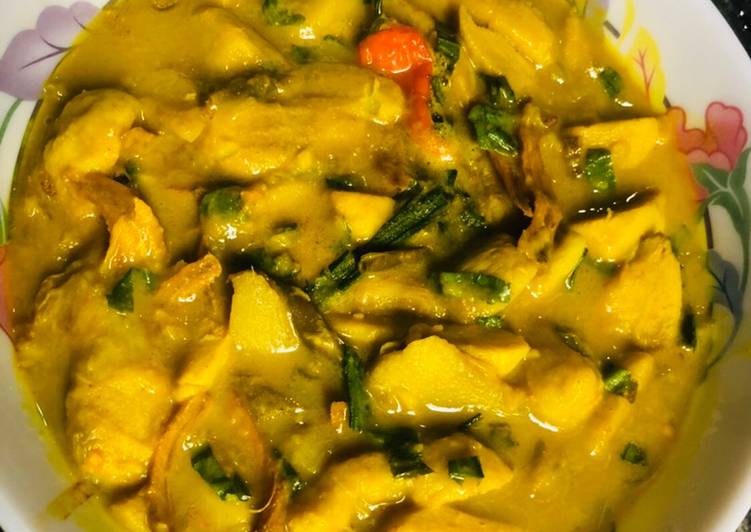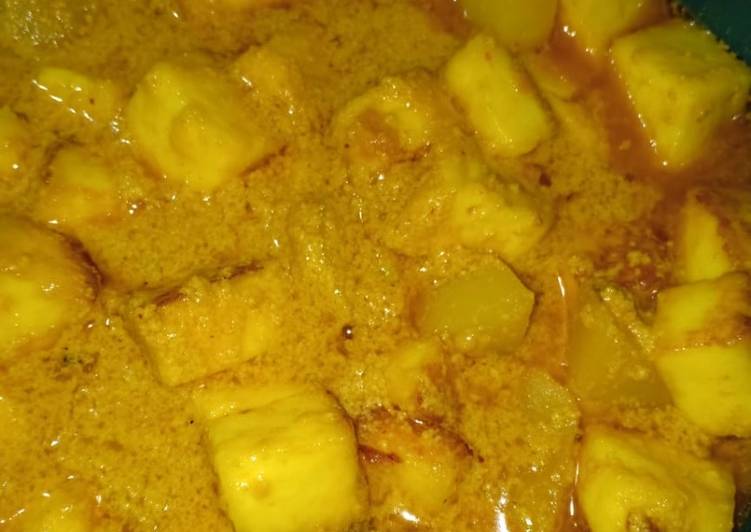
Hello everybody, hope you are having an incredible day today. Today, I will show you a way to prepare a distinctive dish, shutki diye taro (dried fish with a root vegetable). One of my favorites. This time, I’m gonna make it a bit tasty. This will be really delicious.
Shutki diye taro (dried fish with a root vegetable). shutki or dried fish (any variety of your choice), mukhi (colocasia/taro), diced, Onion, Garlic, Cilantro/coriander leaves-, Mustard oil , Green chillies, Habanero (naga morich). Links for my previous similar recipe: Shobji diye Shutki (loitta) / Dry fish with vegetables https So this video called the life of chilli? chopped chili fish head,red oil sheet jelly Liziqi Channel Most People Never Eat This Giant Taro - Chicken New Curry Recipe With Biggest VEG Taro Mashed.
Shutki diye taro (dried fish with a root vegetable) is one of the most popular of current trending meals in the world. It’s enjoyed by millions daily. It’s simple, it is quick, it tastes yummy. They are nice and they look wonderful. Shutki diye taro (dried fish with a root vegetable) is something that I’ve loved my entire life.
To begin with this recipe, we have to prepare a few components. You can have shutki diye taro (dried fish with a root vegetable) using 10 ingredients and 7 steps. Here is how you cook it.
The ingredients needed to make Shutki diye taro (dried fish with a root vegetable):
- Prepare 50 grams shutki or dried fish (any variety of your choice)
- Make ready 8-10 mukhi (colocasia/taro), diced
- Get 1 big Onion
- Take 1/2 teaspoon Garlic
- Take 1 tbspn Cilantro/coriander leaves-
- Take 1 tbspn Mustard oil
- Take 1/2 Green chillies
- Make ready 1 Habanero (naga morich)
- Make ready 1/2 teaspoon Turmeric powder
- Take As per taste Salt as required
Taro root, or satoimo (里芋)in Japanese, are a different matter though, because it has a texture that divides people sharply into like and dislike: sliminess. The taro leaves are heart shaped with white roots that are It has many healing properties that are useful to get rid of many diseases. Large taro roots can be fibrous, dry, and mealy when cooked but have a nutty sweetness. Roasted taro will have a light, dry, chewy texture, and sweet flavor.
Steps to make Shutki diye taro (dried fish with a root vegetable):
- Method: - Wash the dried fish well and chop out the head portion. Drain the water properly.
- Heat oil in a pan and add sliced onion, garlic paste, turmeric powder and green chilies (chopped/slit). Fry them and add salt to taste.
- When the oil seperates, add the dried fish. Cook for a while and cover the pan.
- Now add the chopped taro and stir in properly. Keep the lid on but keep checking frequently to avoid the scorching.
- Add 2 cups of water and let it come to a boil. Turn down the heat to slow cook.
- When the fish and vegetables are cooked, stir in one slit naga morich and finely chopped cilantro/coriander leaves.
- Turn off the heat. Put the lid back and allow some standing time. Serve with steamed rice.
Stir-fry or fry thinly sliced taro and serve with a sauce. Taro can be sliced into chips or strips and pan-fried or deep-fried. Colocasia esculenta is a tropical plant grown primarily for its edible corms, a root vegetable most commonly known as taro (/ˈtɑːroʊ, ˈtæroʊ/), or kalo in Hawaiian. Taro is sometimes referred to as "taro root," too, but while we're getting technical, the part of the plant we eat that is grown underground (the leaves and leaf-stems are edible, too) is not the roots, but rather the corms and cormels. Although called as taro balls, those small balls might be made from trao and sweet potato.
So that’s going to wrap this up with this special food shutki diye taro (dried fish with a root vegetable) recipe. Thank you very much for reading. I’m sure you will make this at home. There is gonna be interesting food in home recipes coming up. Remember to save this page in your browser, and share it to your loved ones, friends and colleague. Thanks again for reading. Go on get cooking!


